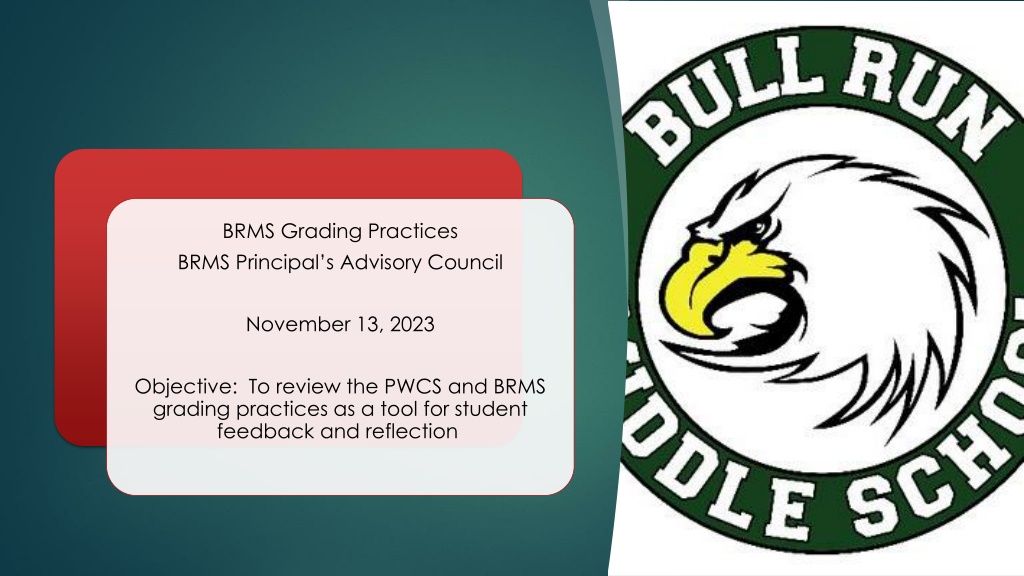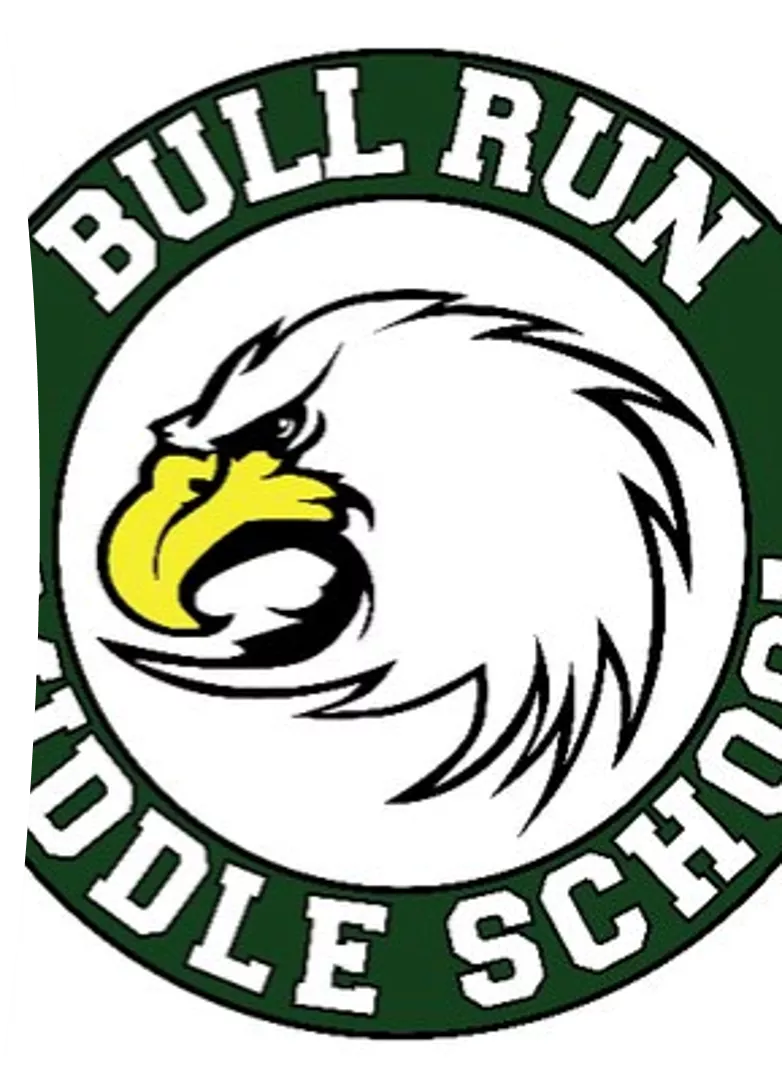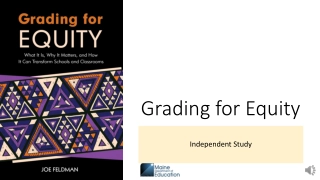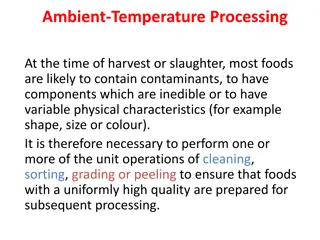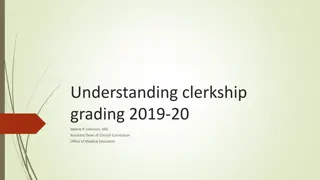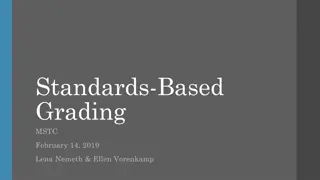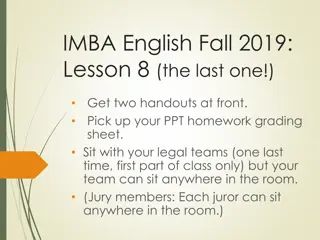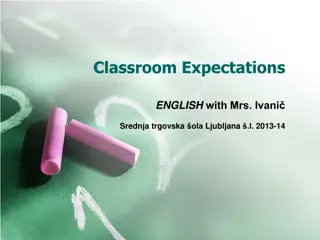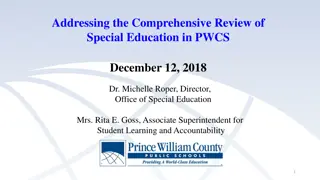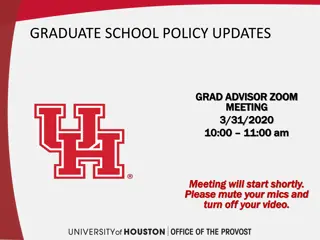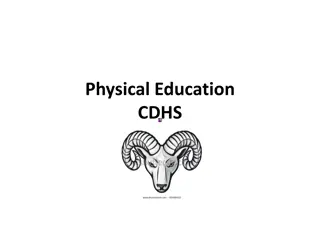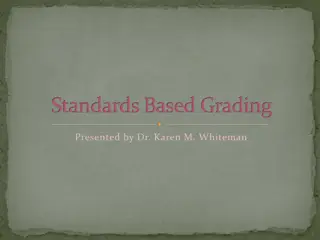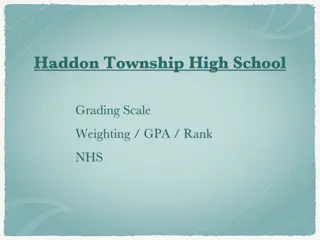Review of Grading Practices in PWCS and BRMS
This document outlines the assessment and grading practices in Prince William County Schools (PWCS) and Bull Run Middle School (BRMS) with a focus on providing feedback, enhancing student learning, and aligning assessments with learning outcomes. It includes information on assessment purposes, formative and summative assessments, grading practices, and the use of rubrics for scoring assignments. The objective is to review and reflect on these practices as tools for student feedback and improvement.
Download Presentation

Please find below an Image/Link to download the presentation.
The content on the website is provided AS IS for your information and personal use only. It may not be sold, licensed, or shared on other websites without obtaining consent from the author. Download presentation by click this link. If you encounter any issues during the download, it is possible that the publisher has removed the file from their server.
E N D
Presentation Transcript
BRMS Grading Practices BRMS Principal s Advisory Council November 13, 2023 Objective: To review the PWCS and BRMS grading practices as a tool for student feedback and reflection
PWCS Regulation 661-2 Assessment and Grading Practices - Middle Assessment Practices Academic assessments are a means of gathering evidence of student learning of the PWCS curriculum and state standards for a specific purpose, including to: 1. Pre-assess or diagnose a student s current state of knowledge or skill; 2. Check for understanding of new learning; 3. Provide feedback to increase student learning; and 4. Evaluate student performance in a specified domain.
Assessment Practices- Middle Level The purpose of giving any academic assessment shall be clearly communicated by the teacher and understood by the student. Professional educators and educational leaders shall ensure that assessments are aligned with required learning outcomes. Professional educators shall construct learning objectives for their lessons that identify the conditions and criteria that shall be used to assess student learning. Professional educators shall provide students with an explanation of the desired learning outcomes and how their performance shall be measured, in clearly worded, student-friendly language. Professional educators and educational leaders shall ensure that assessments used in the Division provide adequate evidence to measure for their intended purpose.
Assessment Practices-Middle Level Frequent formative assessments shall be used to provide students with practice opportunities to build knowledge and skill. Summative assessments shall be used when students have had sufficient opportunities to demonstrate their readiness through formative assessment. Feedback on assessments shall be timely, whether it is graded or not, to enhance student learning. Staff shall ensure time for instruction is protected from excessive use of assessment measures. Assessments shall be graded using the practices outlined in this regulation.
PWCS Grading Practices Graded tasks shall be aligned with the PWCS curriculum and state standards, and shall support student learning. Academic achievement grades shall not include measures of student behavior. Types of Graded Assessments: Professional educators are encouraged to use a wide variety of evidence to determine level of mastery of the desired learning goals. Evidence may include but are not limited to observations, labs, essays, unit assessments, works of art, performance, problem-based learning, multimedia productions, oral examination/verbal responses, discussion, presentations, quizzes and tests, and culminating activities or projects. Rubric Scoring: Teachers are encouraged to mark/score assignments using rubrics that are aligned with the Grade Scale or Simplified Grade Scale used in Attachment I or II of this regulation, rather than the 101-point percentage-based scale, which is subject to distortion. Percentage Grades: Difficulties in accurately distinguishing between 101 different levels of achievement are caused when using the 101-point scale (0-100). Using fewer, more precise measures articulated in a rubric can help to more accurately assess student mastery of a standard(s).
PWCS Grading Practices Titles of Assignments in Gradebooks: Grades shall be recorded by learning objectives and standards, using descriptive titles rather than type/category descriptions (e.g., 6.4 causes of the American Revolution, rather than homework 1, quiz #2, chapter 4 test, or class participation). Number of Graded Assignments: Teachers shall use professional judgment in determining how much evidence is necessary to evaluate student performance on a standard(s). To ensure sufficient evidence to evaluate student achievement, a minimum of nine assignments shall be given in a grading period. A single assessment shall not count for more than 20 percent of a marking period grade. Group Grading: Cooperative learning can be an effective learning strategy. Students shall be assessed for their contribution to a group assignment when their roles and assignment expectations are clearly articulated. Weighting Formative and Summative Assessments: Grading categories and/or weights may be used in the electronic gradebook program to distinguish formative from summative assessments.
PWCS Grading Practices Multiple Opportunities: Research demonstrates that assessment and grading can effectively promote continuous learning when students receive descriptive feedback on their work and are provided second chances. Such practices increase student motivation and persistence in the face of challenging work. Providing students with new learning opportunities prior to making a second attempt on assessments holds the greatest potential to improve student learning when using retakes. 1. All students benefit from the opportunity to reassess their level of mastery, after demonstrating reflection on previous practice and demonstrating additional preparation for reassessing their knowledge and skill. 2. Grade levels shall collaborate on reassessment opportunities they provide to students, using the professional judgment of the staff. 3. Setting appropriate deadlines for reassessment shall be done collaboratively by the school grade level teams.
PWCS Grading Practices Grade Replacement: Earlier evidence of learning on previously graded assignments may be marked exempt in the electronic gradebook when new evidence of student achievement demonstrates improvement, in accordance with the professional judgment of the teacher. Late Work and Missed Assignments: Late work and missed assignments shall be accepted to document student proficiency on the standard(s). Grade levels shall work together with their educational leaders to set reasonable guidelines for turning in late work and encourage the completion of missing assignments.
Reporting Grades 1.Graded tasks shall be returned promptly to maximize the impact that timely feedback has on improving student learning. 2.Grades shall be updated using the Division s reporting system at least once per week. 3.The report card grading scale can be found in Attachment II to this regulation. 4.The final yearly grade shall be calculated by summing the point values of the four nine-week grading periods and dividing the total number of grading periods. 5.To ensure the final grade represents the level of a student s achievement and progress, the final yearly grade may be modified by the teacher to improve the student s grade when the calculation by average inaccurately communicates the teacher s assessment of student performance and improvement over time.
Consistent Approaches for Bull Run Middle School 1. Learning Targets visible in the classroom. The learning objective should be written in student friendly learning targets, aligned with the VA SOL, and clear, evident and visible to the students. Written on board or posted on paper. No posters, no multiple targets. Consistent and clear for students. Targets should be posted in Canvas as well with the learning target icon. 2. Gradebook setup: Naming of assignments by objectives and standards. Should be the same across grade level content groups. The assignments may be different, but the standard is the same. Links of assignments back to Canvas are required. 3. Minimum of 9 assignments per quarter. Grades must be updated weekly. No one assignment is weighted more than 20%. 4. Weighting: 90% Summative, 10% Formative. Two stars for Summative one star for Formative in Canvas. 100% Summative is okay, as well as 60% Summative/30% Summative 2. and
Example of how to assess student Learning Students are learning required Standards of Learning that are adopted by the Virginia Department of Education. 6.7 The student will investigate and understand that air has properties and that Earth s atmosphere has structure and is dynamic. Key ideas include a) air is a mixture of gaseous elements and compounds; b) the atmosphere has physical characteristics; c) properties of the atmosphere change with altitude; d)there is a relationship between air movement, thermal energy, and weather conditions; e) atmospheric measures are used to predict weather conditions; and f) weather maps give basic information about fronts, systems, and weather measurements. a) b)
Essential Knowledge and Practices Enduring Understandings In order to meet this standard, it is expected that students will identify the composition and physical characteristics of the atmosphere (6.7 a) Earth s atmosphere is comprised of interacting and interdependent elements that are subject to change in response to inputs and outflows of energy and matter. Air is a mixture of gaseous elements and compounds. These include nitrogen, oxygen, water, argon, and carbon dioxide. Nitrogen makes up the largest proportion of air (6.7 a). The atmosphere is made up of layers (troposphere, stratosphere, mesosphere, and thermosphere) that have distinct characteristics (6.7c). Students are not expected to know specific altitudes or temperatures at each layer. Naturally occurring ozone is also found in the atmosphere and helps to shield Earth from ultraviolet radiation (6.7 c). Example of how to assess student Learning analyze and interpret charts and graphs of the atmosphere in terms of temperature and pressure (6.7 b) measure and record air temperature, air pressure, and humidity, using appropriate units of measurement and tools (6.7 b) The atmosphere is dynamic because of the number of factors that affect it, such as pressure and temperature, which change with altitude and latitude. Air exerts pressure. Air pressure decreases as altitude increases (6.7 b). Moisture in the air is called humidity (6.7 b). Temperature decreases as altitude increases in the lowest layer of the atmosphere (6.7 b). Data on characteristics such as barometric pressure, temperature, wind speed and direction, humidity, and dew point can be collected, analyzed, and used to predict weather (6.7 b, d). predict weather conditions based on air temperature, barometric pressure, and humidity (6.7 b, e) differentiate among the layers of the atmosphere in terms of general characteristics and changes in altitude (6.7 c) explain the impact of the addition of thermal energy on air movement (6.7 d) Thermal energy transfer from the sun or from other geosystems influences air movement and weather conditions. The amounts of thermal energy and water vapor in the air and the pressure of the air largely determine weather conditions (6.7 d, e). compare types of precipitation (6.7 e) compare weather-related phenomena, including thunderstorms, tornadoes, hurricanes, and drought (6.7 e) Models constructed based on patterns in atmospheric conditions are used to predict weather. Most of the air that makes up the atmosphere is found in the troposphere (the lowest layer). Virtually all weather takes place there (6.7 c, e). Weather maps show useful information about air measurements, observations, and boundaries between air masses (fronts). The curved lines showing areas of equal air pressure and temperature are key features of weather maps. Weather maps are important for understanding and predicting the weather (6.7 f). interpret basic weather maps, including the identification of warm and cold fronts (6.7 f) map the movement of cold and warm fronts and interpret their effects on observable weather conditions (6.7 f).
